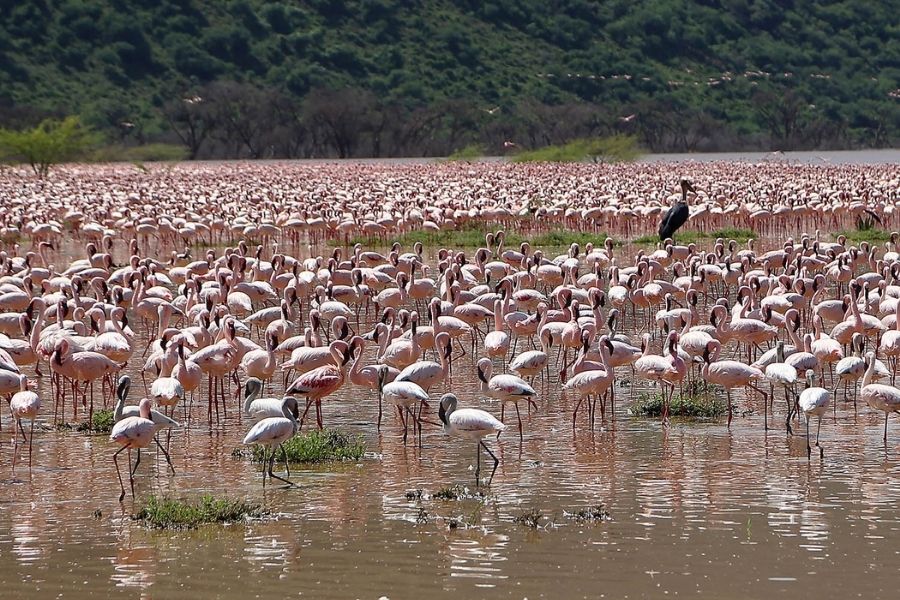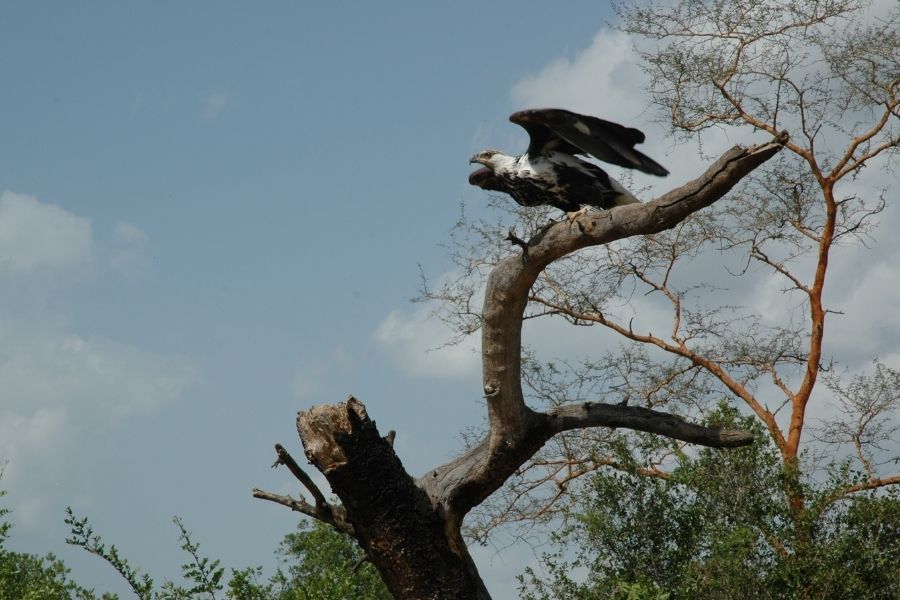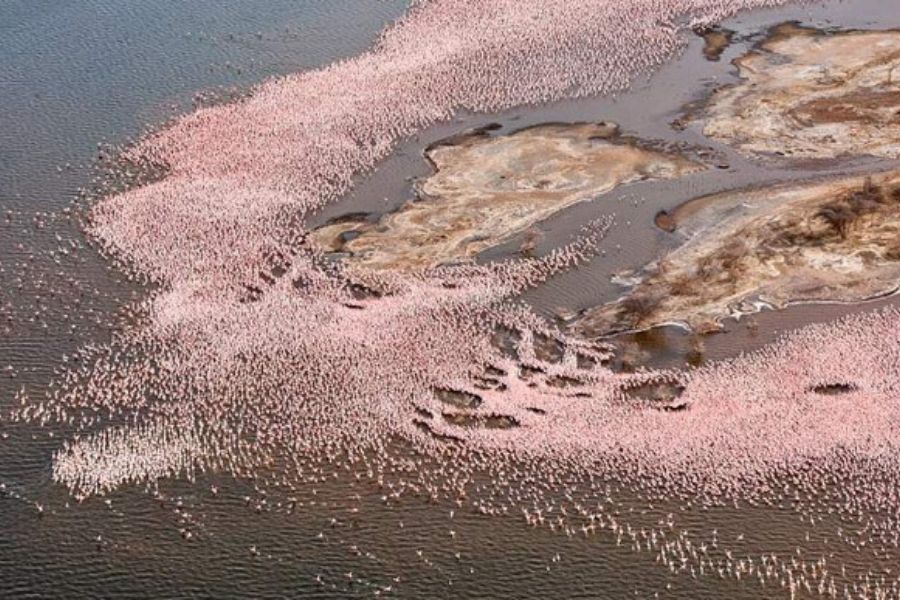Wings Over Kenya: Exploring One of the World's Richest Birdwatching Destinations
Where birds, landscapes, culture, and safari unite in unforgettable harmony.
If you’ve ever dreamed of standing beside a flamingo-studded lake at sunrise, hearing the call of a turaco echo through rainforest canopies, or watching a superb starling shimmer like stained glass in the morning sun, Kenya is where your wings should take you.
With over 1,088 recorded bird species, Kenya proudly hosts nearly 12% of the world’s birdlife. It’s not just the numbers that impress—it’s the ease, variety, and cultural richness that comes with birding here. You won’t need to hike for days or camp deep in the jungle. You’ll find world-class birding in city parks, forest trails, lakeshores, coastal mangroves, and even alongside elephants and giraffes.
Let’s journey through Kenya’s birdwatching heartland, where every feathered moment is backed by tribal wisdom, scenic beauty, and wildlife magic.
Recommended 12-Day Birding Safari Circuit (Well-Routed & Time Efficient)
Nairobi → Naivasha/Elementaita → Nakuru → Lake Bogoria → Lake Baringo → Kakamega Forest → Ruma/Lake Victoria → Mount Kenya/Aberdare → Arabuko Sokoke/Coast.
The Journey Begins in Nairobi – Birds in the Shadow of Skyscrapers
Notable Birding Spots:
◾ Nairobi National Park
◾ Karura Forest
◾ Ngong Road Forest Sanctuary
◾ Nairobi Arboretum
Your birding adventure can start the moment you land in Nairobi. This vibrant capital is not only Kenya’s cultural and logistical hub—it’s also surprisingly bird-rich. In Nairobi National Park, just minutes from the airport, you can spot over 500 species, including raptors, sunbirds, and even the elusive Secretary Bird striding through the grasslands.
Head into Karura Forest or Ngong Road Forest Sanctuary, where Mousebirds scramble like mammals and Hartlaub’s turaco flashes red in flight. At your lodge garden? Superb starlings—brilliantly blue and copper—will greet you like old friends.
And right in the city’s rhythm, the Hadada ibis, with its echoing “ha-ha-ha” call, becomes your urban alarm clock.
It’s a magical reminder: in Kenya, nature isn’t far.
Cultural Visit:
◾ Visit a Kikuyu homestead near Ngong or Limuru to learn about the tribe’s agricultural practices and traditional herbal knowledge.
Combo Option: Nairobi National Park – Birdlife + David Sheldrick + Giraffe Centre!
Lake Naivasha and Lake Elementaita – Rift Valley Mosaics
2 hrs from Nairobi
Just two hours from Nairobi, the landscape opens into the Great Rift Valley—a birding hotspot unlike any other. At Lake Naivasha, African fish eagles call from acacia trees, pelicans glide low over calm waters, and Malachite kingfishers flash neon at the water’s edge.
Birds to Spot:
◾ Elementaita: Lesser flamingos, Avocets, Black-winged stilts, Goliath heron
◾ Great white pelicans, African fish eagles, Malachite kingfisher
◾ Flamingos (esp. at Elementaita), African jacana, Cormorants
Other Birding Areas:
◾ Nearby Trails: Crescent Island, Elsamere, Kigio Wildlife Conservancy, and Soysambu Conservancy
◾ Maasai cultural visit in the Elsamere area—learn about pastoralism and bird coexistence.
◾ Nearby, Lake Elementaita offers something more delicate. Here, the pink haze you see in the distance isn’t dust—it’s thousands of flamingos feeding on blue-green algae in alkaline waters. Their numbers rise and fall with the seasons, but when they gather, it’s one of the most photogenic scenes in Africa.
◾ In the evenings, the air fills with the cries of crowned plovers and African spoonbills, while hippos grunt offshore.
Menengai Crater Rim for raptors
Additional Spotting Site:
◾ Hyrax Hill for archaeology + highland species like the Abyssinian thrush
◾ Augur buzzard, Grey-headed gull, Black-winged stilt, Helmeted guinea fowl
◾ Lesser & Greater Flamingos, African spoonbill, Red-billed teal, Grey-headed gull, Secretary bird
Star Species:
While the birds are the stars, you’ll also find white rhinos, giraffes, and elusive leopards among the euphorbia-studded slopes.
From the elevated baboon cliffs, look down on shimmering flocks of greater and lesser flamingos, while grey-headed gulls, African fish eagles, and Hamerkops wade the shallows. Marabou storks—massive, hunched scavengers—patrol both the park and the town center, unfazed by humans.
Moving just an hour north, you reach Lake Nakuru, arguably one of Kenya’s most iconic birding destinations. Once famous for millions of flamingos, it now thrives with a broader range of birdlife as water levels have risen.
1 hr from Elementaita
Lake Nakuru National Park – Flamingos, Raptors & Rhino Country
Visit Kalenjin villages and learn about the cultural symbolism of birds in local folklore.
Bonus Wildlife: White rhino, Rothschild’s giraffe, leopard
Lake Bogoria – Kenya’s Flamingo Kingdom
2 hrs from Nakuru: Travel from Ruma via Nakuru (or air transfer from Kisumu to Eldoret → 2.5 hr drive)
When water conditions shift, and flamingos migrate en masse, they often settle at Lake Bogoria, about two hours from Nakuru. This alkaline lake is framed by volcanic ridges and steam-belching geysers, creating a dramatic backdrop for one of nature’s most dazzling shows.
At dawn, the lake becomes a mirror reflecting millions of lesser flamingos. Their deep pink bodies and jet-black beaks form a moving mosaic. Greater flamingos, more elegant and pale, mingle among them with curved bills dipped into the mineral-rich shallows.
Birding here is not just about what you see—it’s how it feels: the smell of sulfur, the flurry of pink wings, and the shimmer of heat rising from the water.
Why It Matters:
A UNESCO-listed Ramsar Site, Bogoria hosts millions of flamingos, especially when levels at Nakuru shift. It’s also home to geothermal geysers and volcanic features.
A UNESCO-listed Ramsar Site, Bogoria hosts millions of flamingos, especially when levels at Nakuru shift. It’s also home to geothermal geysers and volcanic features.
Birds to Watch:
◾ Bogoria: Lesser flamingos and Greater flamingos, Spur-winged goose, African spoonbill
◾ Heuglin’s courser, Verreaux’s eagle-owl, Jackson’s hornbill, Nubian woodpecker
Steppe eagle, Tawny eagle, African darter, Little grebe
Spur-winged goose, Wood sandpiper, Three-banded plover
Tribe: The Endorois people, traditional custodians of the lake. Visit local eco-projects where traditional and bird conservation knowledge intersect.
The Endorois people still live traditionally, honoring the sacredness of the lake and working on community-led eco-conservation projects.
Bogoria Bonus: Watch hot springs and geysers bubble beside flamingo colonies!
Safari Add-On: Combine with game drives in Lake Baringo or Laikipia conservancies.
Lake Baringo – Lowland Jewel and Night Bird Paradise
1 hr from Bogoria
An hour beyond Bogoria lies Lake Baringo, a freshwater lake offering a complete change in habitat. This is dry, acacia-dotted terrain, and it’s teeming with birds you won’t see elsewhere.
You’ll spot Verreaux’s eagle-owl, Slender-tailed nightjar, and the jewel-like Northern red bishop. Early morning boat rides reveal African darters, goliath herons, and hippos emerging silently from the depths.
Known For:
Baringo is a lowland birding haven—over 470 species, including arid-land specialists and rare night birds.
Baringo is a lowland birding haven—over 470 species, including arid-land specialists and rare night birds.
Bird Highlights:
Heuglin’s courser, Verreaux’s eagle-owl, Jackson’s hornbill, Slender-tailed nightjar
Egyptian goose, Little bittern, Goliath heron
Cultural Visit: Interact with the Njemps community, semi-nomadic pastoralists who fish and herd, rare in this bird-rich lake environment.
Evenings bring music from the local Njemps community, and mornings might be shared with hornbills, bee-eaters, and one of Kenya’s highest densities of nesting weavers.
Kakamega Forest – Kenya’s Only Equatorial Rainforest
5 hrs from Baringo: Travel from Ruma via Nakuru (or air transfer from Kisumu to Eldoret → 2.5 hr drive)
A dramatic shift westward takes you to Kakamega Forest, a remnant of the once vast Congo Basin. Here, the landscape turns emerald. The trees soar, the canopy hums with cicadas, and the air is thick with moisture and birdsong.
This is where the great blue turaco—a magnificent blue-and-yellow bird the size of a turkey—glides like royalty across the treetops. In the understory, you may hear the illadopsis, or catch glimpses of Hornbills, Broadbills, and Double-toothed barbets.
Why It’s Unique:
Kenya’s only equatorial rainforest and part of the Eastern Afromontane biodiversity hotspot.
Kenya’s only equatorial rainforest and part of the Eastern Afromontane biodiversity hotspot.
Target Birds:
Great blue turaco, Black-and-white-casqued hornbill, Blue-headed bee-eater
Turner’s eremomela, African blue flycatcher, Yellow-billed barbet
Meet Luhya healers and learn how birds play into forest myths and local medicine.
Accompanied by Luhya community forest guides, your birding walks are not only rich in species but layered with cultural insights, from traditional medicine to bird-based folklore.
Ruma National Park & Lake Victoria – Rare Swallows and Luo Traditions
3 hrs from Kakamega: 3 hrs from Kakamega, near Homa Bay
Further west, near Homa Bay and the shores of Lake Victoria, lies Ruma National Park. It's the only place in Kenya where you can spot the blue swallow, a globally vulnerable species that migrates here seasonally.
Ruma is also home to the roan antelope, another Kenyan rarity, alongside a rich mix of grassland birds and raptors.
Birds of Interest:
Blue swallow (migratory), Papyrus gonolek, Shoebill (rare), African paradise flycatcher
Marabou stork, Silverbird, African fish eagle
◾ Meet the Luo tribes, known for their riverine and lake ecology, fishing songs, and nyatiti instruments.
◾ Extend your journey to Rusinga Island, where fishing villages along the lakefront share songs, rituals, and conservation efforts with visiting birders. The Luo people here have a deep connection to the lake, and their oral traditions often feature the fish eagle and stork as spiritual messengers.
◾ Safari Extension: Roan antelope sightings at Ruma = rare!
Mount Kenya & Aberdare Ranges – Birding in the Highlands
Fly to Nanyuki or Travel via Nyahururu to Nanyuki (~4 hrs)
Best Trails:
Zaina Falls, Chania Waterfall, The Ark, and Treetops lodges
As your route turns east toward central Kenya, the landscape shifts again. In the Mount Kenya Forests and Aberdare Ranges, you’re birding at altitude—over 2,000 meters—where thick bamboo forests and highland moorlands reveal some of Kenya’s most elusive species.
Key Birds:
Look for the Hartlaub’s turaco, scarlet-tufted malachite sunbird, and Abyssinian ground thrush along cool, misty trails. Overnight at lodges like The Ark or Treetops, where birds visit your balcony feeder as elephants drink below.
Hartlaub’s turaco, Abyssinian ground thrush, Montane white-eye, Scarlet-tufted malachite sunbird
African green pigeon, Bar-tailed trogon
Visit Kikuyu farms near Nyeri or Karatina for agricultural walks—see how birds and crops coexist.The Kikuyu people, who consider Mount Kenya sacred, still protect groves for spiritual rites—spaces where wildlife and worship meet.
Aberdare Bonus:
Treetops and The Ark lodges offer birding from your balcony!
Forest elephants and elusive bongos are seen near bird hides.
Arabuko Sokoke Forest & Mida Creek – Birding on the Swahili Coast
Your final stretch takes you east to the coast, either by road through Tsavo or a short flight to Malindi. Here, among the humid coastal woodlands of Arabuko Sokoke, you’ll find some of Africa’s rarest endemics.
Endemic & Coastal Birds:
The Sokoke scops owl, Clarke’s weaver, and Amani sunbird make their home in these dry forests. And just minutes away at Mida Creek, you’ll switch habitats again—this time, to tidal mangroves alive with crab plovers, Terek sandpipers, and mangrove kingfishers.
Sokoke scops owl, Clarke’s weaver, East Coast akalat
Crab plover, Terek sandpiper, Mangrove kingfisher
Visit Giriama communities, learn about Swahili coastal traditions, and enjoy a dhow cruise at Mida Creek.
Here, the Giriama and Swahili communities are your hosts, offering sunset dhow rides, music, and traditional coconut dishes that make your last birding moments feel like a celebration.
Culture: Visit Giriama or Swahili villages, known for dhow-building, oral poetry, and coconut farming.
Bonus Stop: Watamu Turtle Watch & Bio-Ken Snake Farm
Optional Add-On: Beach extension in Watamu or Diani.
Other Noteworthy Birding Hotspots to Add
| Birding Site | Bird Specialties | Nearest Reserve |
|---|---|---|
| Saiwa Swamp National Park | Sitatunga, Ross's turaco, Narina trogon | Mount Elgon Forest |
| Tsavo East & West | Golden pipit, Somali bee-eater, Martial eagle | Tsavo NP |
| Shaba & Samburu Reserves | Somali ostrich, Vulturine guinea fowl, Palm-nut vulture | Buffalo Springs Reserve |
| Taita Hills Forests | Taita thrush, Taita white-eye (endemic) | Taita Wildlife Sanctuary |
| Maralal Forest & Matthews Range | Hartlaub’s turaco, Ayres’s hawk-eagle | Samburu NP (via Baragoi) |
Final Word: Why Kenya Is a Birder’s Dream
It’s not just about ticking off names on a checklist. Birdwatching in Kenya is about experiencing nature with all your senses, learning from the people who live alongside the birds, and moving through landscapes that change color, culture, and rhythm with every kilometer.
From flamingos to fish eagles, turacos to owls, every feather has a story—and Kenya is where those stories take flight.
FAQs – Birdwatching in Kenya
Q1: Is birdwatching good year-round?
Yes. But for migrants + breeding plumage, October–April is best.
Yes. But for migrants + breeding plumage, October–April is best.
Q2: Can I do birding with kids or as a beginner?
Absolutely. Blavals creates fun, educational bird walks for families, schools, and groups.
Absolutely. Blavals creates fun, educational bird walks for families, schools, and groups.
Q3: Are birding trips private or group-based?
Both! We customize trips for individuals, couples, or small groups, led by certified guides.
Both! We customize trips for individuals, couples, or small groups, led by certified guides.
Q4: What gear should I bring?
Some lodges and guides provide them. But bring yours with you
◾ Binoculars (8x42 preferred)
◾ Bird book/app (Merlin + Stevenson guide)
◾ Notebook/camera/sunhat / refillable water bottle
Q5: Can I combine birding with game drives?
Yes! Most sites are near or within national parks, so you can enjoy both.
Yes! Most sites are near or within national parks, so you can enjoy both.
Q6: Are birdwatching safaris suitable for beginners?
Absolutely. Our trips blend expert guidance with gentle itineraries and include cultural experiences.
Absolutely. Our trips blend expert guidance with gentle itineraries and include cultural experiences.
Q7: Are birding guides available?
Yes. Blavals works with Nature Kenya-certified ornithologists and community bird scouts.
Yes. Blavals works with Nature Kenya-certified ornithologists and community bird scouts.
Here is a book list that you can use to select books to bring along with you or purchase at any book selection store.
Books Every Birding Traveler Should Consider
◾ Field Guide to the Birds of East Africa: Kenya, Tanzania, Uganda, Rwanda, and Burundi. By Terry Stevenson and John Fanshawe, 2001, T &AD Poyser.
◾ Birds of Kenya and Northern Tanzania By D.A. Zimmerman, D.A. Turner, and D.J Pearso, in 1996 (hardback) and 1999 (reduced size), A. & C Black, London.
◾ A Photographic Guide to the Birds of East Africa – Dave Richards
◾ Safari Guide to East African Birds – Jonathan & Angela Scott
◾ Collins Illustrated Checklist: Birds of Eastern Africa – By Ber Van Perlo, 1995, HarperCollins.
◾ Jonathan Scott's Safari Guide to East African Birds. By Jonathan and Angela Scott, KENSTA, Nairobi, 1997.
◾ Beautiful birds of Kenya. By John Karmali, Text Book Centre, Nairobi, 1993.
Available at Nairobi's Book Centre, major bookshops, or online..
Fly High with Blavals – Kenya’s Top Birding Safari Experts
Whether you're tracking forest turacos, watching flamingos paint lakes pink, or ticking off endemics in Sokoke, we’ll build your dream birdwatching journey.
With local birding guides, tribal storytellers, and wildlife extensions, you’ll go beyond the checklist—you'll experience the full rhythm of Kenya’s wild, winged soul.






